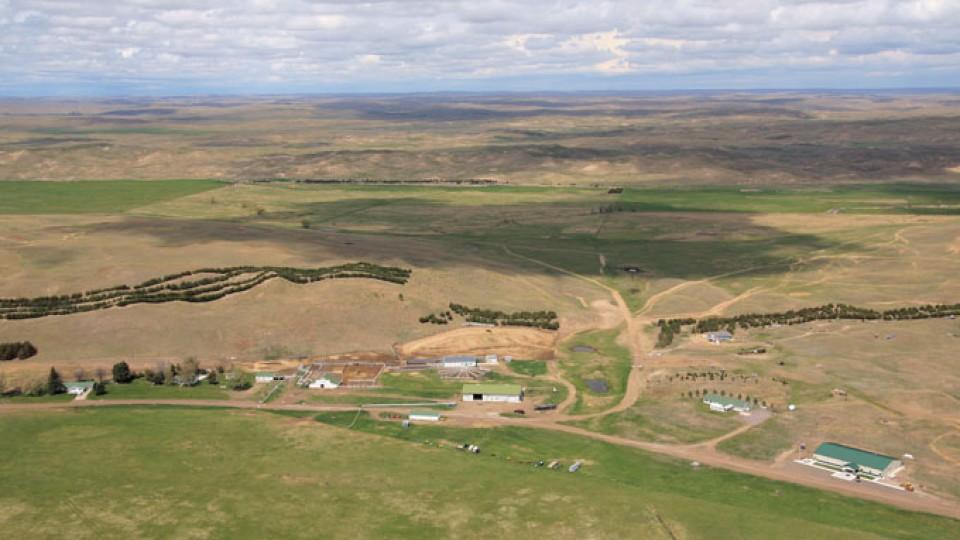Overview
The Gudmundsen Sandhills Laboratory is located in the heart of the Nebraska Sandhills in Grant, Hooker and Cherry counties. In 1978, Elmer "Pete" and Abbie Gudmundsen gave the former Rafter C Ranch to the University of Nebraska Foundation. The University of Nebraska-Lincoln leased the Gudmundsen Sandhills Laboratory from the Foundation in 1981. To convert the Rafter C from an improved commercial ranch to a research-orientated facility, many improvements were made. During the first six years, approximately 17 miles of fence, 24 watering locations, sorting pens, scales, a calving barn and a ranch home were added.
Since Gudmundsen's inception, research and educational programs have become more ecologically diverse and team-oriented. Joint projects with animal, range, soil, veterinary, economics, entomology, geology, hydrology, forestry and wildlife have increased our understanding of the Sandhill's ecosystem. This has resulted in advances in range livestock nutrition, beef cattle reproduction, grazing systems, rangeland ecology, cost-effective cattle management, groundwater issues and wildlife management.

Research faculty involved in these projects are affiliated with the West Central and Panhandle Research Extension and Education Centers, and several departments, as well as the School of Natural Resources on campus in Lincoln.
With the integration of ranch economics into many facets of the research, Gudmundsen has become an integral part in developing plant/animal production systems that are economically and environmentally sustainable in the Sandhills of Nebraska.

The Gudmundsen cowherd consists of approximately 250 March-calving, 250 May-calving cows. About 70 heifers are retained as replacements for each of the herds. The cowherd was originally developed from a group of 450 Angus x Hereford heifers which were purchased in the spring of 1981 and 200 Hereford x Angus x Simmental cows transferred from the Sandhills Ag Lab near Tryon in the fall of 1981. From that time until 1999, the cowherd was exposed to MARC II composite (1/4 Hereford, 1/4 Angus, 1/4 Simmental and 1/4 Gelbvieh) bulls raised at the U.S.D.A. Meat Animal Research Center at Clay Center, Nebraska. In 2000, GSL initiated the use of Husker Red Composite (Red Angus, Gelbvieh, and/or Simmental) bulls developed at UNL by Jim Gosey. Today, Husker Red (Simmental x Red Angus) bulls from the teaching herd at the Eastern Nebraska Research Extension and Education Center are still being used as the herd bulls.
Forage resources include 1,200 acres of subirrigated and wetland meadows along with 11,600 acres of upland sandhills range which includes sands, sandy and choppy sands range sites. Stocking rates for upland and subirrigated meadow are 0.6 and 3.5 AUM's/acre, respectively.
In 1989, a Headquarters/Operations building containing space for the manager's office, equipment storage and a shop area for machinery maintenance was added.
The Dormitory/Conference Center, completed in 1995, provides housing for students and scientists, as well as a place to conduct year-round educational programs and to host groups interested in the research programs.

The Wagonhammer Education Center and Ray Bohy Conference Room, completed in 2005, provide an area to accommodate groups up to 300 people. Included in the Wagonhammer Education Center is a sample preparation area equipped for processing plant, insect, soil and water samples as well as diet and extrusa samples collected from livestock. A manager office and technician office are also housed in the center. A cattle demonstration building was added just east of the Wagonhammer Education Center in 2008.

The additions of the Wagonhammer Education Center and Ray Bohy Conference Room have greatly enhanced the Extension and outreach mission of the Gudmundsen Sandhills Laboratory. Numerous Extension Specialists and Educators use the facility and entire lab for youth and adult programs. A resident manager supervises 2 full-time technicians and directs day-to-day operations at Gudmundsen. Planning and coordination of research and educational activities at Gudmundsen are done by a faculty planning committee comprised of faculty conducting research at Gudmundsen, an Extension Educator and the director of UNL's West Central Research Extension and Education Center in North Platte. In addition, an advisory committee comprised of local ranchers has been instrumental in the development of the annual Gudmundsen Open House, held the end of August each year.

The Nebraska Ranch Practicum is an educational program that offers hands-on experience to participants and gives them the skills and education they need to be successful in today’s ranching industry. Watch the video to learn more about the Nebraska Ranch Practicum.
Gudmundsen Sandhills Laboratory
GSL Open House
GSL Researcher Newsletter
Subscribe to the GSL Researcher
SubscribeSummer Heat and Forage Growth by Jerry Volesky, Nebraska Extension Range and Forage Specialist. LISTEN
Managing Reproduction, Nutrition & Genetics by Rick Funston, Reproductive Physiologist. LISTEN
IANR Vice President and Vice Chancellor Mike Boehm <span ">recently spoke with KRVN about the Western Rangeland center. LISTEN
Selecting the Optimum Breeding Season Length by Travis Mulliniks, Beef Cattle Nutritionist, Range Production Systems. LISTEN
IANR Vice President and Vice-Chancellor Mike Boehm recently spoke with KRVN about the research happening in beef production at the Gudmundsen Sandhills Laboratory. LISTEN
Check out the BeefWatch Podcasts at UNL for current information.
Replacement Heifer Development With Rick Funston, Reproductive Physiologist and AHDB Beef & Lamb. WATCH NOW
